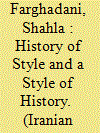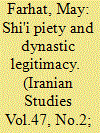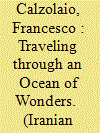|
|
|
Sort Order |
|
|
|
Items / Page
|
|
|
|
|
|
|
| Srl | Item |
| 1 |
ID:
184210


|
|
|
|
|
| Summary/Abstract |
The 17th century was a period of transition in world history. It was marked globally by social movements emerging in response to widespread drought, famine, disease, warfare, and dislocation linked to climate change. Historians have yet to situate Safavid Iran (1501–1722) within the “General Crisis.” This article, coauthored by an environmental historian and a climate scientist, revisits primary sources and incorporates tree-ring evidence to argue that an ecological crisis beginning in the late 17th century contributed to the collapse of the imperial ecology of the Safavid Empire. A declining resource base and demographic decline conditioned the unraveling of imperial networks and the empire's eventual fall to a small band of Afghan raiders in 1722. Ultimately, this article makes a case for the connectedness of Iran to broader global environmental trends in this period, with local circumstances and human agency shaping a period of acute environmental crisis in Iran.
|
|
|
|
|
|
|
|
|
|
|
|
|
|
|
|
| 2 |
ID:
184813


|
|
|
|
|
| Summary/Abstract |
This article considers style in Persian literary history and its critical rhetorical and hermeneutical roles for poets and critics in the medieval and Safavid-Mughal eras. It explores how tarz (manner) emerged as a hermeneutical term in the thirteenth and fourteenth centuries and achieved a central position in sukhansanjī (evaluating speech) in the seventeenth and eighteenth centuries. This account of tarz—grounded in its historicity and multivalent implications—offers new insights into language for early modern Persian literary history, which is often periodized as sabk-i hindī (Indian style) or tāza-gūyī (fresh-speaking). Through a close reading of Safavid-Mughal tazkiras (literary compendiums), this contribution examines tarz as an operating concept deployed by a number of prominent tazkira writers. Finally, the article concludes by discussing this legacy's impact on twentieth-century scholarship.
|
|
|
|
|
|
|
|
|
|
|
|
|
|
|
|
| 3 |
ID:
184161


|
|
|
|
|
| Summary/Abstract |
This article undertakes a comparison between Safavid Iran and modern Pakistan with the aim of highlighting the similarities and differences between their respective state projects of crafting ‘Islamic’ polities. The comparison proceeds through a focus on the state-sanctioned practice of ritual cursing of Sunnis and Ahmadis in Safavid Iran and Pakistan respectively. In both cases, the states made extensive legal efforts to mark out these religious Others by vilifying them on charges of heresy and innovation. This article argues that this vilification was oriented towards creating homogeneity among political subjects of the polity, who were required by the state to curse and condemn these religious Others in order to demonstrate their submission to sovereign power. Ritual cursing thus functioned as an oath of submission that was elicited by the state to draw subjects into the project of sacralizing the polity and to discipline them into reproducing the normative order of the sovereign power. There are also significant differences between the two cases that throw light on the historical specificity of different modes of sovereignty in early modern and modern Muslim polities. While Safavid kings sacralized their realm through the diffusion of scriptural law moulded to enhance their own sovereign power, the Pakistani state is engaged in the sacralization of the national body politic through its official religious nationalist ideology.
|
|
|
|
|
|
|
|
|
|
|
|
|
|
|
|
| 4 |
ID:
129001


|
|
|
|
|
| Publication |
2014.
|
| Summary/Abstract |
Mashhad, the site in northeastern Iran of the shrine of the eighth Shi?i imam, is arguably one of the largest and wealthiest sacred shrines in the world. The gilded dome over the imam's mausoleum stands amidst an expansive complex of courts, monumental gateways, libraries, museums, guesthouses, and administrative offices that cater to thousands of pilgrims each year. This paper examines the period, under the aegis of the early Safavid shahs, when Mashhad was established as the preeminent Shi?i pilgrimage center in Iran. Appropriating the Timurid ecumenical vision for the shrine, the Safavid shahs refashioned the holy city into a site that celebrated the triumph of Twelver Shi?ism in the Safavid realm and reinforced Safavid claims of legitimacy. While highlighting Shah Tahmasb's personal devotion to Mashhad, and his privileging of the shrine within Safavid sacred topography, the paper focuses on Shah ?Abbas's urban reshaping of Mashhad and the architectural and institutional expansion of the shrine during his reign, thereby enhancing its status as the leading spiritual center in the Safavid empire.
|
|
|
|
|
|
|
|
|
|
|
|
|
|
|
|
| 5 |
ID:
186906


|
|
|
|
|
| Summary/Abstract |
The Safīna-yi Sulaymānī (The Ship of Sulaymān), one of the foremost Persian travelogues from the Safavid period, includes a geographic description of East and Southeast Asia centered on the Indian Ocean. While the Safīna is well-known to scholars, secondary literature on this part of the book is scant and often characterizes it as incoherent and devoid of value. This paper challenges this interpretation through providing a new reading of this text. By casting it in a comparative framework with earlier books of wonders, this paper argues that the geographic section of the Safīna articulates an original view of the Indian Ocean resulting from the encounter between the traveler's observations and experiences and the Islamic tradition of wonders, the ʿajāʾib. As such, it encapsulates one of the central intellectual developments in early modern knowledge production, i.e., the tension between independent inquiry (taḥqīq) and imitation of earlier authorities (taqlīd).
|
|
|
|
|
|
|
|
|
|
|
|
|
|
|
|
|
|
|
|
|